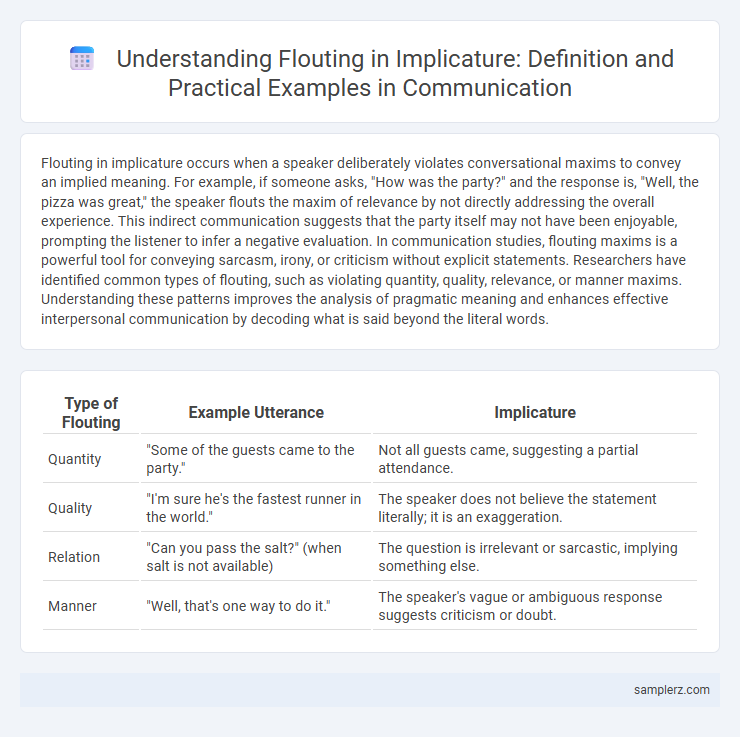Flouting in implicature occurs when a speaker deliberately violates conversational maxims to convey an implied meaning. For example, if someone asks, "How was the party?" and the response is, "Well, the pizza was great," the speaker flouts the maxim of relevance by not directly addressing the overall experience. This indirect communication suggests that the party itself may not have been enjoyable, prompting the listener to infer a negative evaluation. In communication studies, flouting maxims is a powerful tool for conveying sarcasm, irony, or criticism without explicit statements. Researchers have identified common types of flouting, such as violating quantity, quality, relevance, or manner maxims. Understanding these patterns improves the analysis of pragmatic meaning and enhances effective interpersonal communication by decoding what is said beyond the literal words.
Table of Comparison
| Type of Flouting | Example Utterance | Implicature |
|---|---|---|
| Quantity | "Some of the guests came to the party." | Not all guests came, suggesting a partial attendance. |
| Quality | "I'm sure he's the fastest runner in the world." | The speaker does not believe the statement literally; it is an exaggeration. |
| Relation | "Can you pass the salt?" (when salt is not available) | The question is irrelevant or sarcastic, implying something else. |
| Manner | "Well, that's one way to do it." | The speaker's vague or ambiguous response suggests criticism or doubt. |
Understanding Flouting in Conversational Implicature
Flouting in conversational implicature occurs when a speaker intentionally violates a conversational maxim to convey a hidden meaning. For example, if someone asks, "How was the movie?" and the response is "Well, the popcorn was good," the speaker flouts the maxim of relevance to imply the movie was disappointing. Recognizing these violations allows listeners to infer implied messages beyond the literal content, enriching communication understanding.
Classic Examples of Maxim Violations
Flouting the maxim of quantity can be seen when someone gives overly detailed or insufficient information, such as responding to "How was the movie?" with a lengthy description of the cinematography instead of a simple judgment. Violating the maxim of quality occurs when a speaker knowingly provides false or exaggerated statements, like claiming "I have seen the Eiffel Tower from my window" without truth. The maxim of relation is flouted when responses seem irrelevant, as answering "Do you want coffee?" with "I have a meeting at 3" shifts focus away from the question's intent.
Flouting the Maxim of Quantity: Saying Too Much or Too Little
Flouting the Maxim of Quantity occurs when a speaker intentionally provides more or less information than required to communicate a message effectively, such as answering "I have two cats, a dog, and a parrot" when asked simply about pets, thereby overwhelming the listener with unnecessary details. Conversely, responding with a vague "I have pets" deliberately offers too little information, prompting the listener to infer more context. This strategic over- or under-sharing challenges the cooperative principle, signaling hidden meanings or conversational implicatures.
Flouting the Maxim of Quality: Ironic and Sarcastic Responses
Flouting the Maxim of Quality occurs when speakers deliberately provide information that is blatantly false or exaggerated to convey irony or sarcasm. For example, responding to a disastrous event with "Well, that went perfectly!" signals the speaker's true negative judgment without stating it directly. This use of ironic or sarcastic responses relies on the listener's ability to recognize the intentional breach of truthfulness to infer the speaker's actual meaning.
Flouting the Maxim of Relation: Changing the Subject
Flouting the Maxim of Relation involves deliberately changing the subject to mislead or avoid relevance in conversation, creating an implicature that prompts listeners to infer meaning beyond the literal words. For example, when asked about missing a deadline, responding with unrelated information about recent weather implicitly signals avoidance or discomfort. This tactic exploits conversational expectations, encouraging interlocutors to read between the lines for intended messages.
Flouting the Maxim of Manner: Delivering Ambiguous Messages
Flouting the Maxim of Manner occurs when a speaker intentionally provides ambiguous or obscure messages to provoke thought or convey hidden meanings beyond the literal interpretation. For example, responding to a question like "How was the concert?" with "You know, the usual mix of highs and lows" deliberately obscures details, prompting the listener to infer dissatisfaction or complexity. This strategic ambiguity enhances conversational implicature by encouraging listeners to read between the lines and derive implied meanings.
Everyday Flouting in Social Interactions
In everyday social interactions, flouting conversational maxims often involves exaggeration to convey sarcasm or humor. For instance, responding to a friend's obvious question with an absurdly detailed answer intentionally breaks Grice's maxim of relevance, signaling irony. This pragmatic strategy enriches communication by allowing speakers to imply meanings beyond the literal content.
Cultural Variations in Implicature Flouting
Flouting conversational implicatures varies significantly across cultures, as norms for indirectness and politeness dictate how meaning is inferred beyond literal expressions. For instance, in Japanese communication, indirectness and implied meanings are often preferred, and flouting can involve subtle understatement or avoidance of explicit denial to maintain harmony. Conversely, in many Western cultures, direct flouting of implicature, such as sarcasm or irony, is more commonly recognized and expected within conversational exchanges.
Functions and Purposes of Flouting Conversational Maxims
Flouting conversational maxims serves functions such as conveying sarcasm, emphasizing a point, or inviting the listener to read between the lines. For example, deliberately providing an obviously false statement flouts the Maxim of Quality to signal irony or humor. This strategic violation enhances communicative effectiveness by prompting inferential reasoning and enriching contextual understanding.
Recognizing Flouting in Media and Popular Discourse
Flouting in implicature occurs when speakers deliberately violate conversational maxims to convey additional meaning, often requiring the audience to interpret the intended subtext. Recognizing flouting in media and popular discourse involves identifying exaggerated statements or ironic remarks that challenge literal interpretation, such as sarcastic headlines or hyperbolic social media posts. Understanding these cues enhances critical media literacy by revealing underlying messages beyond surface content.

example of flouting in implicature Infographic
 samplerz.com
samplerz.com